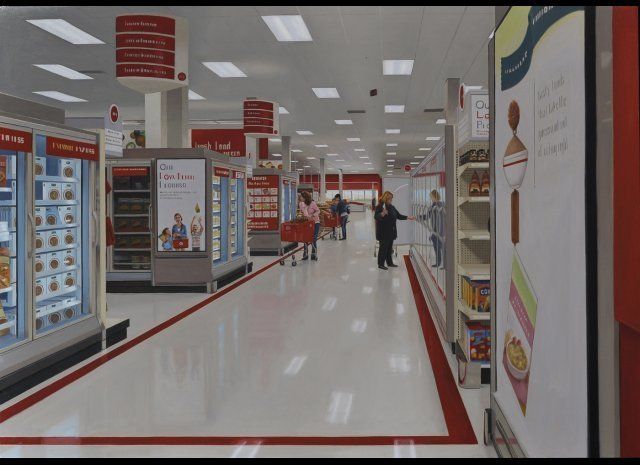Los Angeles based artist Marc Trujillo, whose first solo show at Hirshl and Adler opens on November 3, paints what he calls the "shared spaces of the everyday." He is attracted to "non-destinations," familiar places where vast expanses of concrete or linoleum numb the senses. "I'm captivated by the middle ground," Trujillo explains, "the purgatory of the world we've made and share as North Americans."
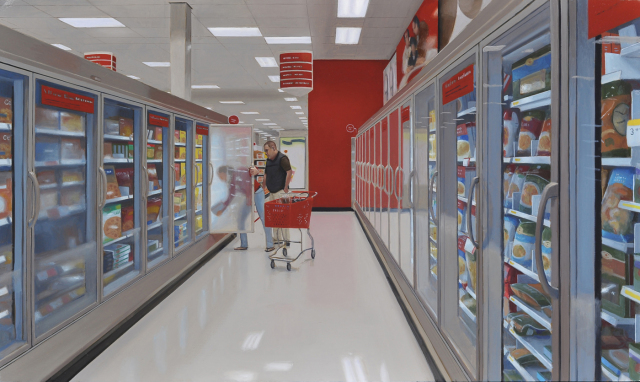 />
/>
Marc Trujillo, "5901 Douglas Avenue," 2010, 11.5" x 19.5," oil on panel
Trujillo sees what he calls "visual potential" in mundane subject matter: big box stores and fast food meals. Painting with a moral seriousness reminiscent of Chardin or Vermeer, Trujillo finds poetry in the gap between ubiquity and invisibility. He evokes both shame and awe in what he records, and uses formal intelligence to make the two conflicting emotions balance.
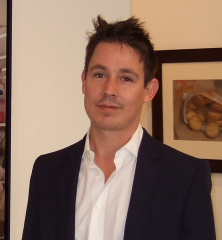
Marc Trujillo
Q and A: John Seed Interviews Marc Trujillo:
JS: Tell me something about fast food as subject matter; what are you seeing and thinking when you paint, for example, a KFC meal?
MT: I believe Auden's statement about poetry being the precise expression of mixed feelings. So what interests me about painting these is how I love them and hate them, just like with the more panoramic paintings I have a mix of awe and shame about them that makes me interested in painting them. I'm from a square state and have had a lot of fast food growing up, so it can be comforting and when I'm in the mood I can enjoy it, but them again it's a little disgusting and low grade. I didn't want to paint a KFC meal as a seen from the side: "still life as landscape." I wanted the viewer looking straight down at it; it's your meal.
Also, I wouldn't normally order the corn on the cob but it comes wrapped in foil which I wanted to paint, so my motives were also visual when I was ordering this meal.
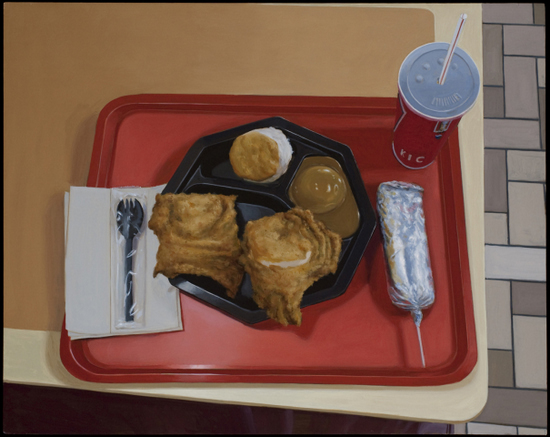
Marc Trujillo, "Meal #2," 2011, 13.5" x 17," oil on panel
JS: Who are some artists that have influenced you? Where can we see their influence in their work?
MT: My main influences are Vermeer, Velasquez, and Rembrandt.
My paintings are fundamentally synthetic in nature, and represent not only the experience of direct observation, but also an appreciation and awareness of paintings and painters of the past. I swipe strategies to see what works for me.
When I see Vermeer's 'View of Delft' for example, my first reaction is emotional, followed by a desire to analyze what makes it a great painting. The scale is perfect, substantial but not imposing, so when I'm not sure what size a painting should be I'll use the 38" height of 'View of Delft' as a starting point and set the width of the painting according to my needs for the composition. Vermeer had to construct his moment and he took liberties -- in the reflections in the water for example -- with physics to get the moment he wanted for the painting.
The light in 'View of Delft' is very convincing; light is how you sell the fiction of the painting as a real moment. The artificial light in the spaces I paint is very different from the light in the old master paintings I admire, but my interest in conveying it clearly is the same.
Also Vermeer uses the vanishing point in 'Milkmaid' over her hand pouring the milk to help imbue a private moment with meaning -- the opposite of the kind of moments I tend to show and I'll invert his compositional strategy -- so in the parking garage painting for example, there's nothing under the vanishing point but concrete.
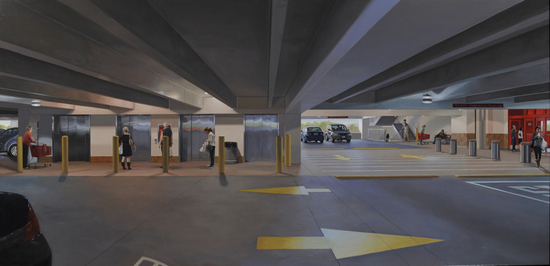
Marc Trujillo, "5711 Sepulveda Boulevard," 2010, 30" x 62," oil on canvas
JS: Is it fair to call your work documentary? What is your intention when you show us the kinds of generic places and spaces that you favor?
MT: It would be a misreading to call them documentary. They're real places, but I do a lot to them so that they could be anywhere; no palm trees for example. I'm from New Mexico so to me a palm tree says vacation or movie happy ending. Showing people things that can be part of their fantasy lives is a good definition of pornography. I want the painting to have a chance to be more of an experience than the actual place so that's one reason I pick places people don't go to be there. If I painted the Himalayas then the painting would function more like a postcard that reminds the viewer of someplace they would rather be.
The paintings are the acid test for all of the ideas I have going into them. Making the paintings is what defines the area of investigation for me, as opposed to starting with an idea and executing it. So my ritual is a cycle; looking at great paintings to define painting for myself, looking at the world to see what I think might make an interesting painting as I've come to understand and define it, and testing all of this by making the paintings themselves, which starts the process of investigation all over again.
The locations in the paintings are non-destinations, particularly North American kinds of nowhere, at once ubiquitous and yet largely unseen. These places give me the slightly sinking feeling that I know I'm somewhere, but not really there, present in an absent sort of way. In the mix of shame and awe that I feel, I am inspired by the potential for painting what I'm experiencing in the moment.
JS: What else should viewers understand about your work?
MT: I think the big thing that people misunderstand is that they see the paintings as being "Photorealistic." My paintings are built on drawings as opposed to being painted from photographs. In order to sort out how I want to convey what I'm experiencing in these spaces, I need to draw.
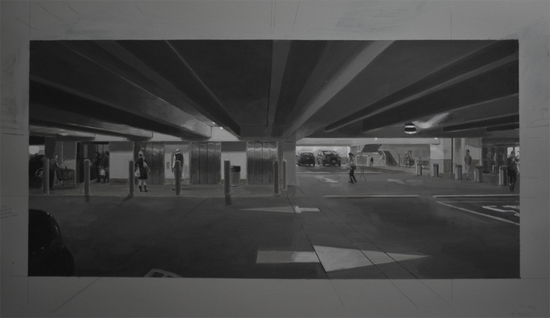
Marc Trujillo, 2nd preparatory drawing for 5711 Sepulveda Boulevard
For me making is thinking. This stage is vital as it's where I test the potential for painting a given situation; clearing an isle to keep the deep space open, changing the proportions of the space slightly and leaving in only the elements that convey my interest in the space and the figures that occupy it.
Marc Trujillo
November 3rd - December 3rd 2011
Hirschl and Adler Modern
Opening Reception -Thursday, November 3rd, 5:30 to 7:30 pm
730 Fifth Avenue, New York, NY 10019
